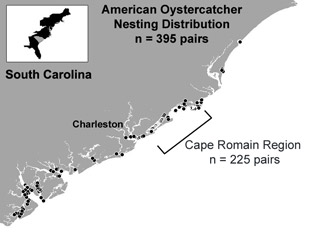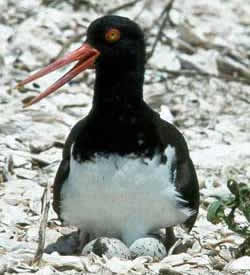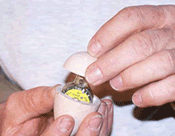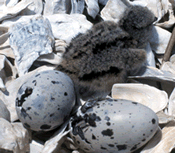American Oystercatchers Nesting in South Carolina

Oystercatchers nest in coastal areas having little vegetation or cover. They lay their eggs in a shallow depression on sandy beaches or shell mounds. Parents are very territorial and protective of nest sites. To estimate the South Carolina breeding population, potential nest sites were surveyed from late April to mid May, during the peak nesting period. Surveys were conducted for three seasons (2001-2003). All shell mounds, beachfronts and sand spits were surveyed by boat, on foot or ATV. Locations of pairs were recorded with a GPS unit. The average number of breeding pairs was 400. This is approximately 20% of the Atlantic breeding population. Unfortunately, most nests fail because eggs are destroyed by avian and mammalian predators, washed away by high tides and boat wakes or nests are abandoned due to human disturbance. Low chick production may be placing this species in peril.
Incubation Study



SCDNR documented incubation behavior of American oystercatchers at White Banks in the Cape Romain National Wildlife Refuge. Because of the remoteness of these shell islands, they are free of terrestrial predators, receive little human disturbance, and are an excellent place to study birds in a natural setting. Characteristics of incubation behavior were documented by using temperature dataloggers placed within wooden eggs. The imitation eggs are the approximate size, shape and color as real oystercatcher eggs. The wooden eggs were placed in nests and were accepted by the parents as real eggs. The dataloggers were programmed to record temperatures every 30 seconds. A control datalogger was placed near the nest to record ambient air temperature. After 2 weeks the wooden eggs and control dataloggers were removed and temperature data was downloaded into a computer. SCDNR examined wooden egg temperatures in relation to ambient temperatures and tidal stage. Intervals where adults were off the nest were identified by decreases in nest temperatures. Oystercatchers left nests during both the day and night for short periods. By comparing incubation behavior on these undisturbed sites with other sites known to be unproductive, we may identify disruption of incubation as one cause of nesting failures.
